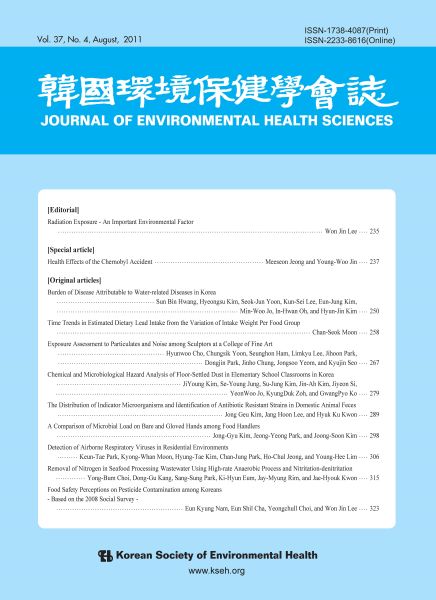- 영문명
- The Distribution of Indicator Microorganisms and Identification of Antibiotic Resistant Strains in Domestic Animal Feces
- 발행기관
- 한국환경보건학회
- 저자명
- 김종규(Jong Geu Kim) 이장훈(Jang Hoon Lee) 권혁구(Hyuk Ku Kwon)
- 간행물 정보
- 『한국환경보건학회지』제37권 제4호, 289~297쪽, 전체 9쪽
- 주제분류
- 공학 > 환경공학
- 파일형태
- 발행일자
- 2011.08.30

국문 초록
영문 초록
Objectives: To estimate the microbial contaminant load discharged from livestock farms, we randomly selected
livestock farmers of cattle, swine, and fowl and collected bacterial strains from domestic animals’ feces and
compost samples. Recently, as multi-antibiotic-resistant bacteria and super bacteria showing resistance to a
variety of antibiotics have been reported one after another, the ecological and health hazard of antibiotic-resistant
bacteria is emerging as an important issue.
Methods: Monitored indicator microorganism constituents were totak coliform (TC), fecal coliform (FC), and
aerobic bacteria. The multi-antibiotic-resistant bacteria were identified from investigated indicator microorganisms
by 16S rRNA sequencing.
Results: By microbiological analysis, the largest population of aerobic bacteria (1.5×105 CFU/g) was found in cattle fecal compost, and total coliforms (1.1×107 CFU/g) and fecal coliforms (1.0×105 CFU/g) were found primarily in swine fecal compost, while the lowest population was found in fowl fecal compost. Among the 67 strains separated from aerobic bacteria, five strains expressing high antibiotic resistance were selected in each sample. We found the multi-antibiotic resistant strains to be Shigella boydii, Staphylococcus lentus, Acinetobacter sp. and Brevibacterium luteolum.
Conclusions: These results suggest that increasing numbers of multi-antibiotic-resistant bacteria in the
environment have a close relation to the reckless use of antibiotics with livestock.
목차
I. 서 론
II. 실험재료 및 방법
III. 결 과
V. 결 론
해당간행물 수록 논문
참고문헌
최근 이용한 논문
교보eBook 첫 방문을 환영 합니다!

신규가입 혜택 지급이 완료 되었습니다.
바로 사용 가능한 교보e캐시 1,000원 (유효기간 7일)
지금 바로 교보eBook의 다양한 콘텐츠를 이용해 보세요!


